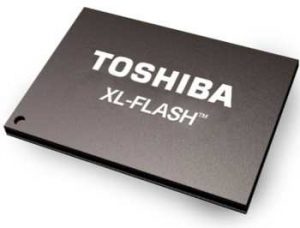FMS: Toshiba Memory Unveils XL-Flash Storage Class Memory Solution
Sitting in between DRAM and NAND flash, it brings increased speed, reduced latency and higher storage capacities, at lower cost than traditional DRAM.
This is a Press Release edited by StorageNewsletter.com on August 5, 2019 at 2:54 pmToshiba Memory America, Inc. (TMA), U.S.-based subsidiary of Toshiba Memory Corporation, announced the launch XL-Flash, a Storage Class Memory (SCM) solution.
Based on the company’s BiCS flash 3D flash memory technology with 1-bit-per-cell SLC, XL-Flash brings low latency and performance to data center and enterprise storage. Sample shipments will start in September, with mass production expected to begin in 2020.
Classified as SCM (or persistent memory), with the ability to retain its contents like NAND flash memory, XL-flash bridges the performance gap that exists between DRAM and NAND. While volatile memory solutions such as DRAM provide the access speed needed by demanding applications, that performance comes at a high cost. As the cost-per-bit and scalability of DRAM levels off, this SCM (or persistent memory) layer in the memory hierarchy addresses that issue with a high density, cost effective, non-volatile NAND flash memory solution.
Poised for growth, industry analyst firm IDC estimates the SCM market is expected to reach in excess of $3 billion in 2022 (1).
Sitting in between DRAM and NAND flash, XL-Flash brings increased speed, reduced latency and higher storage capacities – at a lower cost than traditional DRAM. XL-Flash will initially be deployed in an SSD format but could be expanded to memory channel attached devices that sit on the DRAM bus, such as future industry standard non-volatile dual in-line memory modules (NVDIMMs).
Key features:
-
128Gb die (in a 2-die, 4-die, 8-die package)
-
4KB page size for more efficient OS reads and writes
-
16-plane architecture for more efficient parallelism
-
Fast page read and program times. XL-flash provides a low read latency of less than 4μs, approximately ten times faster than existing TLC (2)
As the inventor of NAND flash, the first to announce 3D flash memory technology and a leader in process migrations, the company is positioned to deliver SLC-based SCM with mature manufacturing, proven scalability and time-tested SLC reliability.
“With XL-Flash, we are giving hyperscalers and enterprise server/storage providers a more cost-effective, lower latency storage solution that bridges the gap between DRAM and NAND performance,” noted Scott Nelson, SVP and GM, memory business unit, Toshiba Memory America. “We’re also opening the door for emerging technologies and industry standards that will enable different form factors for low-latency flash memory solutions. SCM is the next frontier for enterprise storage, and our role as one of the world’s largest flash memory suppliers gives XL-Flash a cost/performance edge over competing SCM solutions.“
[1] IDC May 2019 – Worldwide Solid State Drive Forecast, 2019-2023, Doc # US43828819 (34 pages, $4,500)
[2] When compared to TMC’s TLC NAND which has a read latency of approximately 50μs.
Highest performing NAND available claim based on the fact that the die has been designed (16 planes) to provide higher performance than TLC NAND.















 Subscribe to our free daily newsletter
Subscribe to our free daily newsletter


